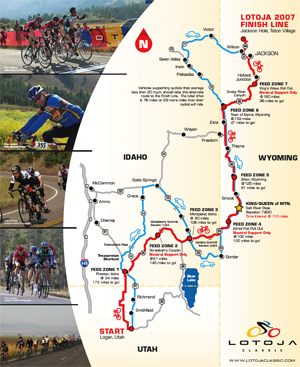
| CONNECTIONS |
IDAHO
ITD
HOME
511 TRAVEL SERVICES
IDAHO
DMV
ITD
NEWS
HIGHWAY
SAFETY
IDAHO STATE POLICE
STATE OF IDAHO
NIATT
NATIONAL
AASHTO
AAMVA
AAA of IDAHO
FEDERAL HIGHWAYS
FEDERAL AVIATION
IDAHO STATE POLICE
NHTSA
NTSB
TRB
U.S. DOT
TRANSPORTER
Archives
Milestones
Comments
Idaho
Transportation
Department
Office of Communications
P.O. Box 7129
Boise, ID 83707
208.334.8005
Fax: 208.334.8563

ITD's
Harelson helps bring stability to traffic
during annual Logan-to-Jackson bike race
Consider
the impact that a cavalcade of 1,000 bike racers and a like number of
support vehicles can have on highways and small communities during a
period of four hours.
Logistics require the precision of a surgeon.
 Dan
Harelson is no doctor, but he’s proven to be pretty good at operations
the past five years as he worked with organizers of the annual Logan,
Utah, to Jackson, Wyo., (LOTOJA) bike race and communities impacted
by the ride.
Dan
Harelson is no doctor, but he’s proven to be pretty good at operations
the past five years as he worked with organizers of the annual Logan,
Utah, to Jackson, Wyo., (LOTOJA) bike race and communities impacted
by the ride.
Harelson, ITD’s District 5 traffic engineer, recognized a significant cultural divide between citizens of quiet eastern Idaho towns and bike racers that streak past their homes and businesses and temporarily fill their streets.
“Not only has he improved bicyclist and motor vehicle safety, but he has identified specific problems in the eyes of local governments and worked hard to resolve those concerns,” explains District 5 Assistant Engineer Blake Rindlisbacher. “At the same time, he has worked with race organizers to ensure the event happens successfully in their eyes.
“Through Dan's coordination efforts and work with race organizers, local governments and law enforcement, the race is welcomed and happens without the drama of previous years,” Rindlisbacher adds.
Harelson and his ITD co-workers have helped coordinate pre-race planning and post-race evaluations related to traffic flow. Race organizers also meet quarterly during the year to plan for the following year’s race. ITD begins its planning efforts in February.
 LOTOJA,
billed as the largest timed race of its kind in the nation, requires
an ITD special event permit that outlines conditions for use of Idaho’s
highways.
LOTOJA,
billed as the largest timed race of its kind in the nation, requires
an ITD special event permit that outlines conditions for use of Idaho’s
highways.
One of the most visible changes is the separation of bicyles and support vehicles, Harelson says. They now travel separate routes to rendezvous at feed stations. That has helped ease race-related congestion and eases the impact on non-race traffic.
At ITD’s suggestion, race organizers also hired an independent traffic control firm to manage traffic along Idaho 34, Idaho 36 and U.S. 89. Proceeds of the race also fund extra sheriff’s deputies and Idaho State Police patrols to ensure safety along the route.
In the interest of safety, eastbound Idaho 36 will be restricted to local traffic and bicycles from about 8:30 a.m. until noon. Traffic also will be restricted in both directions on U.S. 89 to local traffic and bicycles from about 9:30 a.m. until 2 p.m.
Motorists usually will encounter riders in groups of 25 to 30, Harelson explains, partly because of staggered race times in Logan, Utah. The 1,000 riders are divided into 33 “packs” with starts between 6:30 a.m. for top riders and 7:45 a.m. for non-competitive riders.
Race organizers have been very cooperative and eager to work with ITD to ensure safety for riders and motorists and to help communities benefit from the annual visitors, Harelson said.
The event creates a positive economic impact on partnering communities, businesses and organizations along the route. Several volunteer groups within each feed zone community have coordinated fund-raising activities. Proceeds from sales at the feed stations benefit youth groups, Scout troops and business development organizations.
An eight-page “LOTOJA Race Bible” helps riders understand their responsibilities for safety and includes maps and route details and provides information on highway construction and “feed” stations.
Less than half of the 206-mile ride is in Idaho, beginning in Preston and ending at the Wyoming state line.
The race was conceived in 1982 by avid cyclists David Bern and Jeff Keller, both of Logan. According to organizers, the founders “wanted to give cyclists a racing experience that felt like a European road classic, such as the Tour of Flanders or Paris-Roubaix.”
Entry fees and other fund-raising activities associated with the race benefit the Huntsman Cancer Institute and Autism Spectrum Disorder Connections.
The
first race was staged the following year following a route from Logan
to Teton Village in Jackson. The winning time was just over nine hours
by Bob VanSlyke of Logan.
“LOTOJO is a European-style road classic that is unparalleled
in distance and beauty,” according to the race Web site. It is
reported to be the longest one-day event in the country sanctioned by
the U.S. Cycling Federation.
It draws competitors from throughout the country.
Published 9-7-07